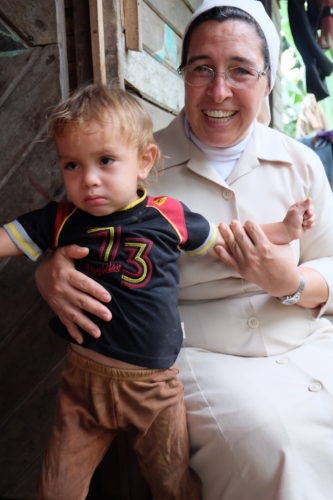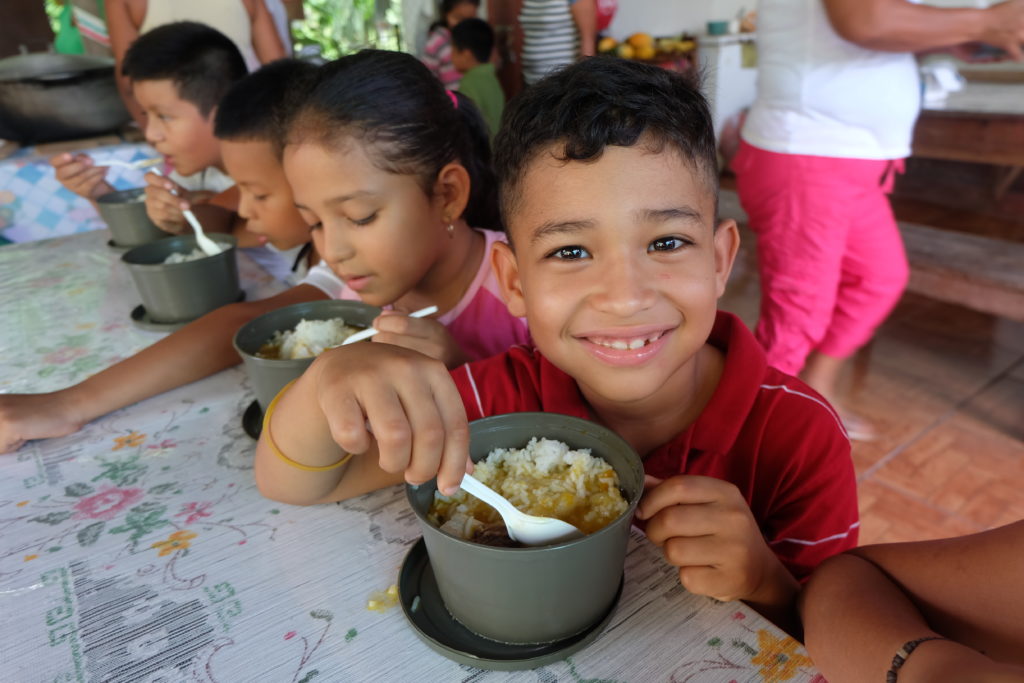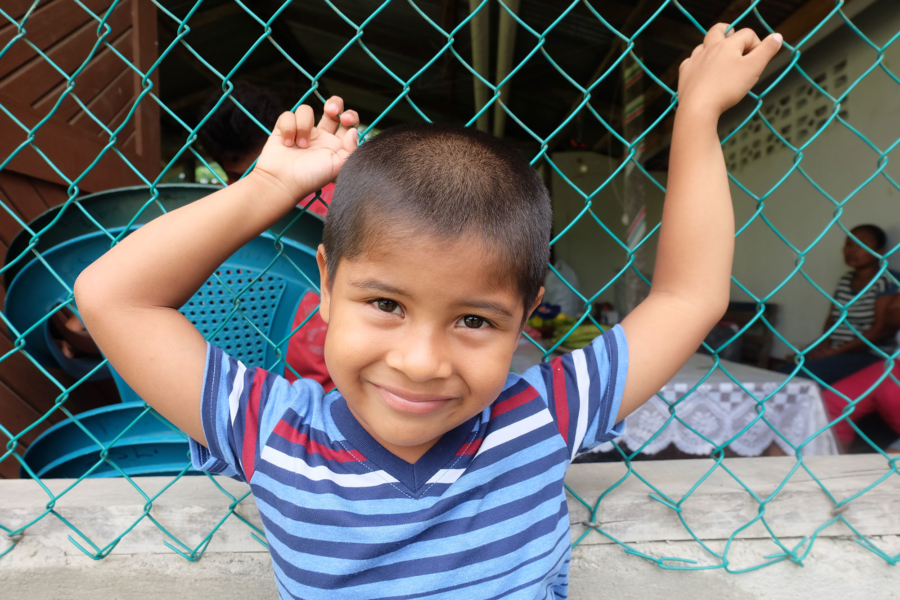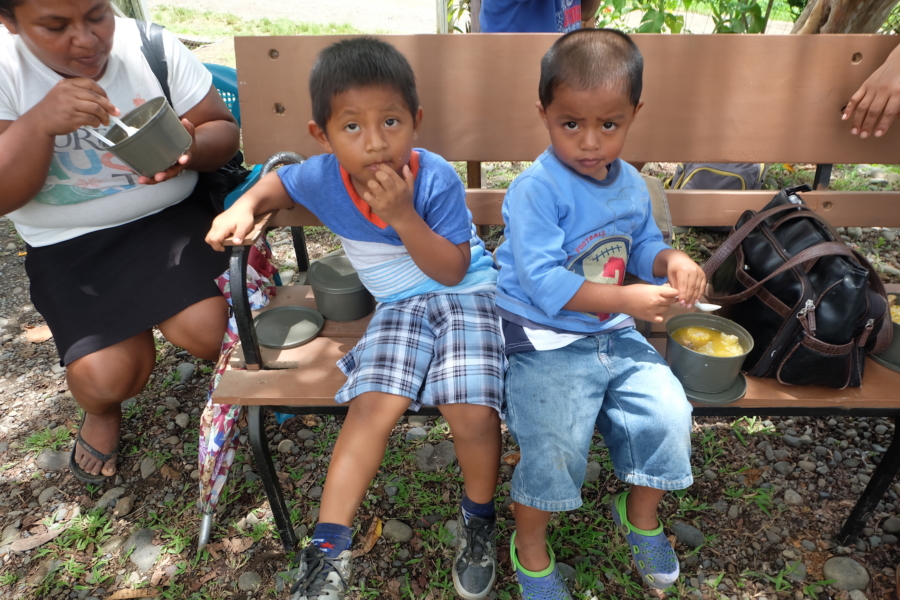A five-hour drive from Costa Rica’s capital is the small town of Bribri in the Talamanca region, southeast of San Jose, along the border of Panama. The town is inhabited mostly by the indigenous Bribri tribe, which is comprised of people who live and work close to the Sixaola River, which separates Costa Rica from Panama by just a short boat ride.
For the last nine years, during five of which Sister Bertalina has been at Santa Luisa, the 83 children in our program have been receiving food, clothing, shoes, and school supplies upon monthly visits to the home.
The area produces various crops, including bananas, plantains, cacao, and a variety of tropical fruits; agriculture provides little income for the families in the region, however. Among the houses and schools within the Bribri community is the Santa Luisa home for the elderly, which not only serves the aging population, but also provides support for children in the community.
A Surprising Connection
We left San Jose at 4:00 a.m. to make the drive to Bribri; we passed over mountains and then drove along the Caribbean coast until the paved road we had been traveling on stopped, and a gravel path lead us into the jungle, the river to the south visible every so often over banana trees.
When we arrived at Santa Luisa, we saw a community center at the entrance gate, and there was a basketball court in front of it. Directly behind it was the home for the elderly, which consisted of four or five separate buildings connected by walkways. Another home sat on a hill above the driveway, where Sister Bertalina, our volunteer coordinator, was waiting for us.

Sister Bertalina with one of our sponsored children
Upon greeting us, Sister Bertalina explained that she had been our coordinator for two years at La Milagrosa in San Jose — which we had visited just the day before — until 2011, when she came to Santa Luisa.
Before that, she had worked at one of our other affiliate sites, Casa Central, in Guatemala as well. In the last ten years, she has been our coordinator for three different sites in two different countries — meaning she has a lot of experience with how to best support the children in our program.
A Community in Need
Sister Bertalina showed us around the grounds of Santa Luisa, which are well-kept and full of chickens, roosters, and fruit trees — all of which provide food for the residents of the home. Santa Luisa is funded and run by the Costa Rican government.
Ten staff members help care for upwards of 25 elderly residents at a time, and the four Sisters that live on the property help to oversee operations, as well as provide support for the children and their families in the surrounding communities through our sponsorship program.
For the last nine years, during five of which Sister Bertalina has been at Santa Luisa, the 83 children in our program have been receiving food, clothing, shoes, and school supplies upon monthly visits to the home.
Both the young and old are being affected by the delicate nature of their families’ economic situations — all because of poverty.
Although the children and the elderly don’t interact with one another during those visits, in many ways, they go to the home for similar reasons. The elderly there have families who are no longer able help them as they become older and unable to care for themselves. Being a casualty of the cycle of poverty, these families can’t afford to take care of aging parents or extended family members, and they are forced to leave them in the government’s care.
This is something that I have become used to seeing with children in our program, but hadn’t yet seen with the elderly. Both young and old are being affected by the delicate nature of their families’ economic situations — all because of poverty. The elderly residents, just like so many children, are lacking the support they greatly need, and are just as vulnerable as children are.
Living in the jungle
After showing us the Santa Luisa grounds, Sister Bertalina took us to visit the home of two children in our program, only a few-minutes drive away. The visit took us deep into the jungle, where at first glance, it didn’t seem that a path off the main road existed at all.
Blanketed by large banana trees, it was narrow and muddy, and it took us up a steep incline. When we arrived at the wooden two-bedroom house, which was built on stilts on the side of a hill, we were greeted by the father, who held his small son in his arms. His wife and their other son were out, but he told us we would meet them at Santa Luisa the next day, when we were to meet with the other sponsored children in our program.

We provided shoes to children thanks to Because International.
The father explained that the roof leaks whenever it rains, which forces them to bag their clothes and tie those bags to the rafters in order to keep their belongings dry.
The family has little money for food because the father makes a very low wage working banana fields. The youngest son is anemic, which makes it difficult to keep him healthy. As we left, Sister Bertalina mentioned that she wants to buy mattresses for many of these families who sleep on the floor or foam padding. She also wishes she could start a nutritional program for the families so she could provide them with vitamins, as well as instructions on how to eat well.
Neither young nor old
The following day, the children went to the center to meet with us, along with their mothers, and some with their fathers, like the family we had met the day before. The children were excited to meet with us, and it gave them a chance to play on the playground, too.
They ran around together until it was time for us to hand out school supplies and shoes we had brought with us for them to take home. Each child received a pair of shoes from Because International, a book bag, pencils, erasers, toothbrushes, and toothpaste.
It is more than just a home for the old which also supports the young — it is a home that makes a difference for everyone in-between in Bribri, too.
After they received their gifts, the mothers served a large meal of rice, potatoes, and vegetables. After we ate, everyone went home for the day, and we said our goodbyes. The family we had visited the day before came to speak with us — the father, the mother, and the two small boys. The parents, who were neither young nor old, expressed their gratitude for the support they receive from our program, thanks to the Santa Luisa home.
It occurred to me how important Santa Luisa is to this community. It is more than just a home for the old which also supports the young — it is a home that makes a difference for everyone in-between in Bribri, too.
***
HOW DO I SPONSOR A CHILD IN COSTA RICA?
You can sponsor a child in Costa Rica in one of two ways – call our office and speak with one of our sponsorship specialists at 1-800-538-5381, or go online to our donation portal, create an account, and search for a child in Costa Rica that is available for sponsorship.




